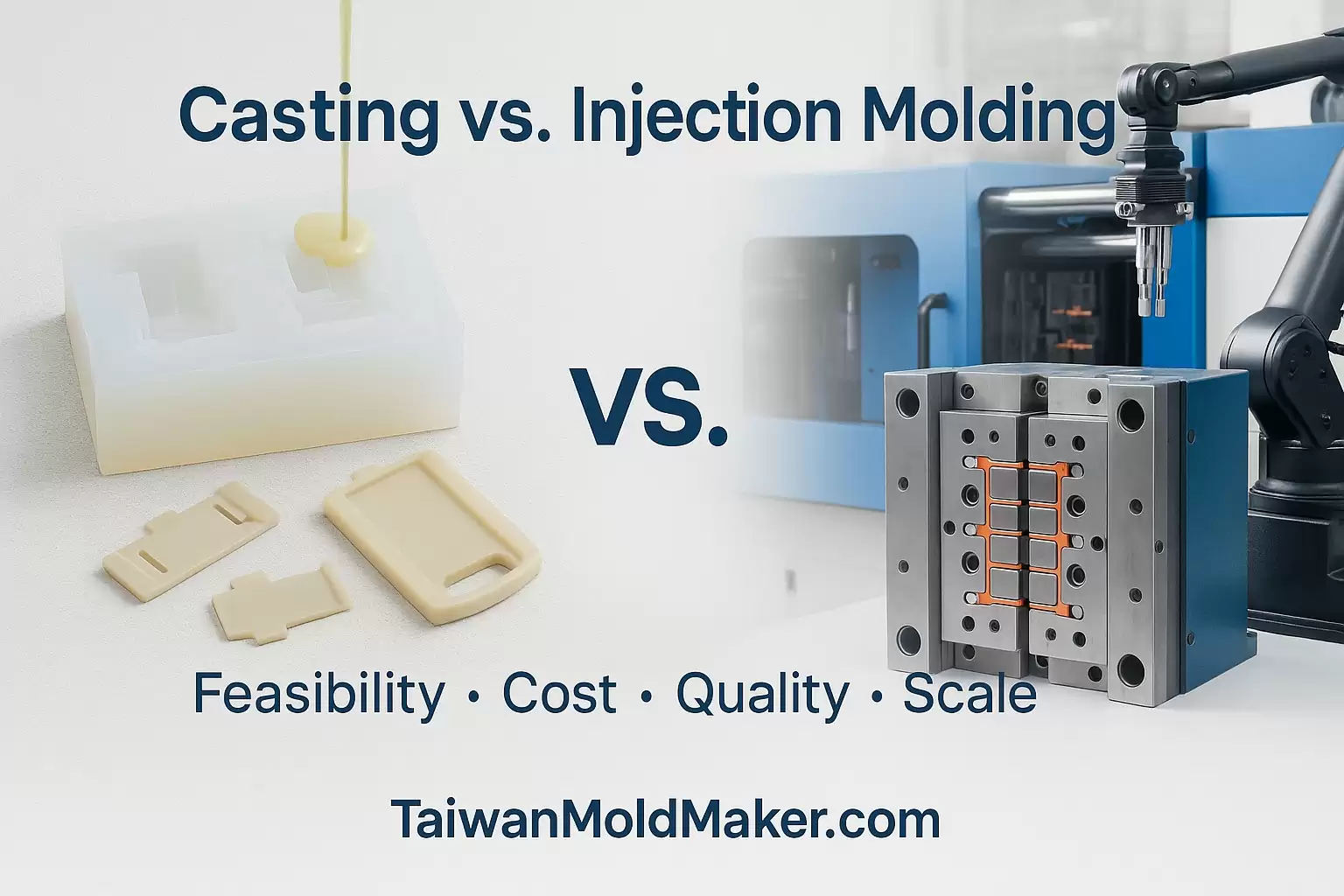Differentiate Casting Plastic and Injection Molding for Product Feasibility and Quality
Differentiate Casting Plastic and Injection Molding for Product Feasibility and Quality
Choosing between casting plastic (e.g., vacuum/urethane casting, room-temperature resin casting, or RIM) and injection molding (IM) determines your timeline, cost, and long-term quality. This guide clarifies when each method fits best—and how to plan an efficient path from early prototypes to mass production with TaiwanMoldMaker.com.
1) Core Differences at a Glance
| Factor | Casting Plastic (Vacuum/Urethane/RIM) | Injection Molding |
|---|---|---|
| Typical Volume | 1–300 pcs/run (up to ~1,000 total per silicone tool) | 1,000 → millions |
| Tooling | Soft silicone/RTV or low-cost composite; hours–days | Aluminum or steel mold; weeks |
| Lead Time to First Parts | 1–5 days | 10–40+ days (bridge → production) |
| Per-Unit Cost | Higher (labor-intensive) | Low once amortized |
| Materials | PU/epoxy urethanes, cast acrylics, RIM polyurethanes | Commodity & engineering thermoplastics (PP, ABS, PC, PA, POM, TPE, LSR, PEEK…) |
| Tolerances | ±0.2–0.5 mm typical | ±0.05–0.10 mm common; tighter with process control |
| Surface & Color | Paint or in-mold colorants; clear urethanes possible | Color-in-polymer, textures (VDI/SPI), optical-grade options |
| Mechanical Profile | Good cosmetics; moderate heat/chem performance | Broad mechanical/thermal/chemical range; better long-term stability |
| Scalability | Limited—tool wear and manual steps | Excellent—multi-cavity, automation, lights-out |
| Regulatory | Limited food/medical options | Full pathways (ISO 13485/10993, IATF 16949, UL, etc.) |
Rule of thumb: Use casting to learn fast and show customers. Use injection molding to scale with repeatable quality and cost.
2) Feasibility Checklist
Choose Casting Plastic When…
-
You need design validation in days, not weeks.
-
Annual demand is < 500–1,000 pcs.
-
Geometry is evolving (frequent ECOs).
-
Parts are large, cosmetic, or need short-term clear/transparent visuals.
-
You’re validating market interest before investing in steel.
Choose Injection Molding When…
-
You forecast ≥ 2,000–5,000 pcs in the first year.
-
Tight tolerances and repeatability are required (snap-fits, seals).
-
Material properties matter (heat, chemicals, impact, biocompatibility).
-
You need overmolding, 2K, inserts, threads, or in-mold labeling.
-
You need traceability, PPAP/IQ-OQ-PQ, and multi-site supply.
3) Cost & Break-Even Logic
Total Cost (Casting) ≈ N × (Unit_Cast)
Total Cost (IM) ≈ Tooling + N × (Unit_IM)
Example:
-
Casting unit cost = $28
-
IM unit cost = $3.50
-
Tooling (aluminum bridge → production steel credit) = $18,000
Break-even volume N* where IM becomes cheaper:
$28N = 18,000 + 3.5N → N ≈ 720 pcs*
If your program exceeds ~720 pcs (for this example), IM reduces total spend and improves quality consistency.
We include a break-even chart in our 48-Hour DFM Pack so you can justify the move to tooling with facts.
4) Quality Considerations
| Quality Attribute | Casting Plastic | Injection Molding |
|---|---|---|
| Dimensional Stability | Sensitive to humidity/temperature; silicone tool growth | Stable after window lock (scientific molding) |
| Cosmetic Repeatability | Good at low volumes; hand finishing variance | Excellent with texture, valve gates, and SPC |
| Long-Term Aging | Some urethanes yellow or embrittle | Thermoplastics maintain performance, can be UV-stabilized |
| Functional Features | Threads/undercuts feasible but manual; limited inserts | Automated inserts, threads, living hinges, 2K/overmold |
| Traceability & CpK | Basic traveler docs | Shot-by-shot MES, CpK ≥ 1.67 targets, lot genealogy |
5) Geometry & Design Rules
Casting Plastic
-
Wall thickness: 2–6 mm recommended to avoid sink/voids.
-
Large fillets/radii reduce bubble traps.
-
Thick masses cure slowly—plan vents and post-cure.
-
Bosses/ribs: keep modest; manual demold defines limits.
Injection Molding
-
Uniform walls: 0.8–3.0 mm depending on resin.
-
Ribs: 0.6–0.8× wall; draft 1–3° per side.
-
Gates: hot runner/valve-gate for cosmetics; fan/tab for thin walls.
-
Overmold windows/undercuts 0.3–0.6 mm for mechanical locks.
6) A Smart Migration Plan: Casting → IM (Bridge) → Mass Production
-
Cast to Learn (Week 1): Validate HMI feel, packaging fit, and basic function with vacuum-cast urethane sets.
-
Aluminum Bridge Tool (Weeks 2–3): Shoot parts in final resin; lock process window and CTQs; run EVT/DVT.
-
Copy-Cavity Steel (Weeks 5–8): Move proven geometry into H13/S136 multi-cavity with hot runner and automation.
-
Scale & Decorate In-Cell: Pad print, laser mark, IML—no extra freight legs.
7) Real-World Examples
-
Cosmetics Lid Program: Cast clear urethane lids in 72 hours for buyer demos → bridge tool in 12 days → VDI 27 texture steel, ΔE-matched color, 0.8% scrap at launch.
-
Wearable Clip: Cast PU clips for comfort trials → PC/ABS injection with TPE overmold; drop-test pass rate rose from 86% to 99%.
8) How TaiwanMoldMaker.com De-Risks Both Paths
| Your Need | Our Solution |
|---|---|
| “I must show buyers parts this week.” | Vacuum casting or 3D-printed injection inserts for real-resin samples in days. |
| “I can’t miss the retail window.” | 48-Hour DFM Pack, aluminum bridge in 10–15 days, steel credit applied later. |
| “We need consistent CpK and traceability.” | Scientific molding, cavity-pressure sensors, MES dashboards (CpK/OEE/energy), PPAP/IQ-OQ-PQ. |
| “Tariffs threaten margins.” | Service-weighted billing to reduce dutiable value on tooling portions (broker-aligned). |
9) Decision Matrix (Pick Your Path)
| Situation | Recommended Route |
|---|---|
| < 300 pcs, evolving ID, demo-ready | Casting Plastic now → plan for IM later |
| 300–1,500 pcs, real resin needed | Aluminum IM bridge tool (may still be faster/cheaper than casting) |
| > 1,500 pcs, tight tolerances & brand cosmetics | Injection Molding with hot runner & automation |
| Overmold, inserts, IML branding | Injection Molding from the start |
Quick-Start with TaiwanMoldMaker.com
-
✔️ Mold Service
-
✔️ Molding
Next Steps—Choose Speed and Quality
-
Upload CAD & forecast (NDA-ready portal).
-
Receive a 48-Hour Feasibility & Cost Pack with a casting vs. IM break-even chart.
-
Approve casting or aluminum bridge tool.
-
Scale to steel multi-cavity with confidence—same team, same data, higher throughput.
Learn fast with casting; win the market with injection molding. TaiwanMoldMaker.com ensures both routes are clear, quantified, and ready to execute.









